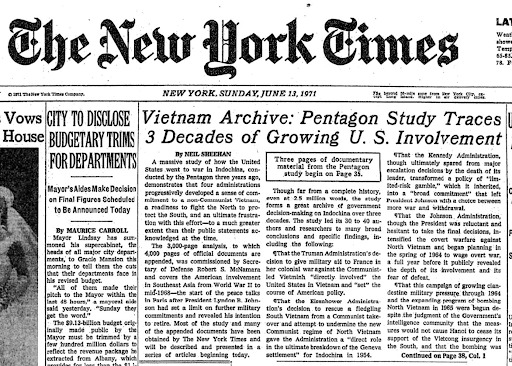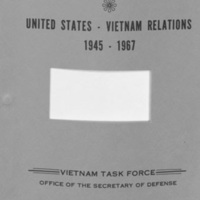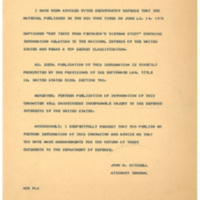New York Times Co. V. United States
By Isabela Carvalho
On June 13, 1971, the New York Times featured as its front-page headline, "Vietnam Archive: Pentagon Study Traces 3 Decades of Growing U.S involvement." The article released the first section of a Department of Defense study of the United States' involvement in the Vietnam War from 1945 to 1967, conducted by Secretary of Defense Robert MacNamara and classified as top secret. Following this, President Richard M. Nixon called for a court order to stop the New York Times and the <Washington Post from publishing the classified papers. The newspaper companies saw Nixon's attempt to censure as a violation of the First Amendment that guaranteed freedom of the press under the American Constitution. It took the order to the Supreme Court in the landmark case New York Times Co. V. United States which sought to guarantee the freedom of the press and continue to release the Pentagon Papers.
The "Pentagon Papers" are a collection of historical records of the Vietnam War through MacNamara's careful analysis of the war's events. The collection contains 47 volumes separated into sections that include "Evolution of the War," "Justification of the War," and essential information on President John F. Kennedy's involvement in Indochina. In addition, it contains many of the Lyndon B. Johnson's administration's military operations and war justifications that the government kept secret. The documents show that more significant American involvement transpired in Vietnam from 1945 to 1967 than presumed by the American population.
Daniel Ellsberg released the documents to the New York Times and the Washington Post. He worked for the RAND Corporation at the time and had access to the "Pentagon Papers." The government charged Ellsberg under the Espionage Act of 1917 for the "illegal" gathering of the papers and releasing them to the public. As a result, Ellsberg risked the conviction of 115 years in prison.This did not stop him from getting the documents to the public eye.
Although the "Pentagon Papers" did not address Nixon's administration, the United States President saw the publication of secret government papers as a threat to future classified documents. On June 14, a day after the New York Times publication, Nixon requested a voluntary stop on the New York Times from publishing further excerpts. The paper denied the appeal. Through the justification of a "breach" in United States national security, Nixon then acquired a "federal court injunction" which prohibited the publishing company from releasing more excerpts. The New York Times appealed the injunction to the Supreme Court in the landmark case New York Times Co. V. United States. On June 18 of the same year, in solidarity with the New York Times' fight against Nixon's federal injunction, The Washington Post released its pieces on the "Pentagon Papers." On June 30, 1971, the Supreme Court sided with the newspaper companies in a 6-3 decision that the government had no basis to stop the companies from publishing the papers.
The New York Times Co. V. The United States case proved momentous. It ruled that the “First Amendment overrides the federal government’s interest in keeping certain documents, such as the Pentagon Papers, classified.” It upheld the role played by the press as the government’s watchdog.
Further readings:
- Bullard, Laura. “We are Going to Publish an Oral History of the Pentagon Papers.” The New York Times, June 09, 2021, accessed October 12, 2022.
- “50th Anniversary of the Release of The Pentagon Papers.” Richard Nixon Presidential Library, June 24, 2021, accessed October 12, 2022.
- Daly, Christopher. “Fifty years ago the Pentagon Papers shocked America — and they still matter today.” The Washington Post, June 13th, 2021, accessed October 12, 2022.
- Dunlap, David. “1971 | Supreme Court Allows Publication of Pentagon Papers.” The New York Times, June 30th, 2016, accessed October 12, 2022.
- “Pentagon Papers.” National Archives and Records Administration. National Archives and Records Administration. Accessed October 12, 2022.





